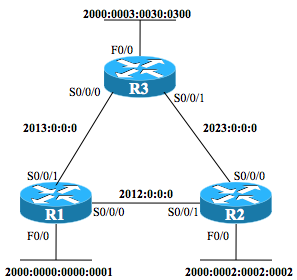Answer, Config Museum Lab: IPv6 Addressing
This blog post simply lists the answers to the earlier lab exercise from a few days ago. This post makes no sense without the first one, so don’t look until you read the other post. No guile, no tricks, just a chance to exercise. The topic for this post: deciphering the shortest abbreviation for each router interface global unicast IPv6 address, and adding the configuration commands. Details below the fold!
Answers: Choosing the Shortest IPv6 Address and Configuring the Addresses
To find the shortest abbreviation for any IPv6 address, just follow these two rules:
- The longest string of consecutive quartets of all hex 0s – replace with a double colon (::)
- In each quartet, remove all leading hex zeroes
In this lab, the figure shows the IPv6 prefix (64-bits/16 hex digits/4 quartets) to use for each subnet. Some of the prefixes are listed in abbreviated form, some not. Then, for the WAN interfaces, the instructions tell you the host ID (last 64 bits/16 hex digits/4 quartets) to use, again with the chance to abbreviate the address. The configurations show the fully abbreviated addresses.
The configuration also shows one command on each router that is not actually required by the lab: the mac-address interface subcommand. I added one to each LAN interface for a small additional question. This command sets the router’s LAN interface MAC address. Given the values, what will the IPv6 address be on the Fa0/0 interface on each of the three routers?
Here’s a quick repeat of the figure, for reference:
Figure: Router Triangle, No Config Yet, with IPv6 Prefixes in Bold

Example 1: R1 Config
ipv6 unicast-routing ! interface FastEthernet0/0 no shutdown mac-address 0200.1111.1111 ipv6 address 2000:0:0:1::/64 eui-64 ! interface serial0/0/0 no shutdown ipv6 address 2012::1/64 clock rate 1536000 ! interface serial0/0/1 no shutdown ipv6 address 2013::1/64 clock rate 1536000
Example 2: R2 Config
ipv6 unicast-routing ! interface FastEthernet0/0 no shutdown mac-address 0200.0002.2000 ipv6 address 2000:2:2:2::/64 eui-64 ! interface serial0/0/0 no shutdown ipv6 address 2023::2/64 clock rate 1536000 ! interface serial0/0/1 no shutdown ipv6 address 2012::2/64
Example 3: R3 Config
ipv6 unicast-routing ! interface FastEthernet0/0 no shutdown mac-address 0200.3333.3333 ipv6 address 2000:3:30:300::/64 eui-64 ! interface serial0/0/0 no shutdown ip address 10.1.88.130 255.255.255.128 ipv6 address 2013::3/64 ! interface serial0/0/1 no shutdown ipv6 address 2023::3/64
Miscellaneous Notes
- The problem statement did suggest that the gear existed in a lab room, which could imply that all the serial links use serial crossover cables (back-to-back cables). As such, one end of each serial link would have the DCE end of the cable connected to it, and therefore require the clock rate command. The lab did not specify which end had the DCE cable, so as long as you picked one end of each serial link for your clock rate command, your config would have met all the intended requirements.

Hmm I got all of the IP addressing correct but I missed all the config for the MAC addresses and serial config, like I didn’t have any of it at all lol.
Requirement 4: “….stateless autoconfiguration using the EUI-64 process”.
I misinterpreted this and i used: ipv6 address autoconfig
Me too. 🙂
I would like some clarification here as well. Doesn’t StateLess Address AutoConfiguration use EUI-64? I guess the wording of the question can be a bit confusing on which to use.
All,
I agree, as worded it at least ambiguous and possibly misleading. I’ll update the copy in the lab exercise. Thanks for the comments.
R1’s F0/0 ipv6: 2000:0:0:1:0:11FF:FE:11:1111
R2’s F0/0 ipv6: 2000:2:2:2:0:FF:FE02:2000
R3’s F0/0 ipv6: 2000:3:30:300:0:33FF:FE33:3333